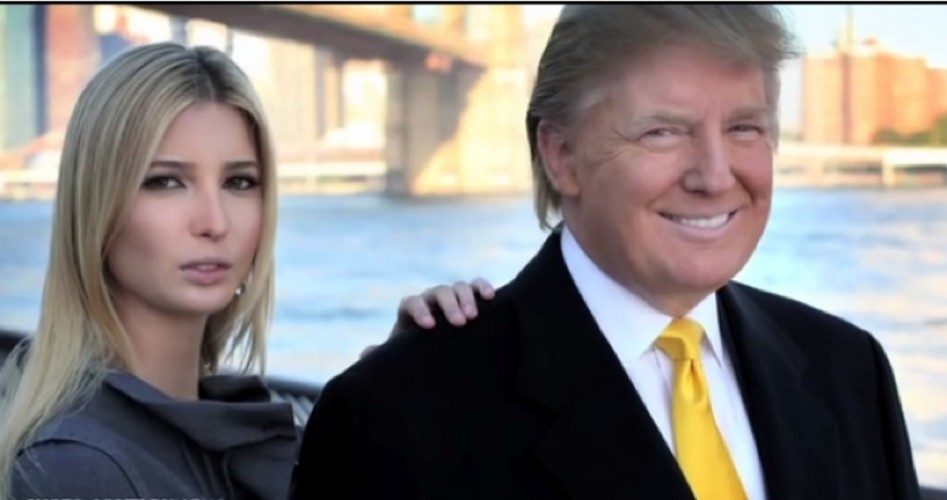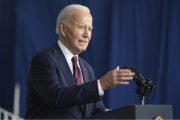
Included in a very long list of Things We Never Expect to See in American Politics is any scenario in which the leftist establishment Washington Post becomes a champion of the Constitution and the Founders’ original intent in framing it. Yet that is precisely what we find in a March 17 article by Pepperdine University School of Law professor Derek Muller, in which we are exhorted to restore the Electoral College system to some semblance of its original form — to prevent Donald Trump (shown on right) from becoming president.
The bipartisan political establishment, be it remembered, has been subverting the Electoral College system for decades, and in recent years, calls for its outright abolition have reached a fever pitch. In August 2013, Newsweek’s Keith Wagstaff noted with approval that Rhode Island had just signed the National Interstate Popular Vote Compact, hastening the time when a majority of electoral votes will be guaranteed by state laws to go to the winner of the popular vote in those states. The aim of this project is the end of the Electoral College system, a goal polls show most Americans support, according to Newsweek. Only one year ago, Chris Walker, writing in the aptly named Elitedaily.com, called for the abolition of the Electoral College, calling it an “archaic system” and ruing the fact that it had led to George W. Bush’s victory over Al Gore in 2000, despite the latter’s having won the popular vote tally.
What a difference a year makes. While the sentiments of the likes of Walker and Wagstaff certainly represented a growing consensus among America’s political elites, the Trump phenomenon — if the Washington Post is any indicator — is causing second thoughts.
“If they choose, state legislators can appoint presidential electors themselves this November, rather than leaving the matter of apportioning Electoral College votes by popular vote,” writes Muller, adding that “via their chosen electors, legislatures could [then] elect any presidential candidate they prefer.”
And he’s absolutely correct. According to the wording of the Constitution, the states are empowered to select the electors for the Electoral College “in such Manner as the Legislature thereof may direct.” In other words, how the electors are appointed and how they vote is a matter to be decided by the individual states; there is no constitutional requirement binding the electors to respect the popular will of voters in their states, either proportionally or as winner-take-all. In point of fact, there was no popular vote at all for president in the early years of the Republic, since it was widely understood that presidents were elected by electors from the separate states, who had been in turn been typically appointed by state legislatures. The Founders were justifiably leery of populism and direct democracy, which is why they reserved the election of representatives for a biennial popular vote, but provided for an Electoral College to elect the president and for state legislatures to appoint senators.
The modern drive to abolish the Electoral College began with the so-called Bayh-Celler constitutional amendment campaign during the 91st Congress in 1969-1971. Exploiting popular anger at the disparity between the comparatively close popular presidential election between Richard Nixon (43.5 percent) and Hubert Humphrey (42.9 percent), and the Electoral College margin of victory for Nixon (56 percent to 35.5 percent), Representative Emmanuel Celler and Senator Birch Bayh, both Democrats, launched a congressional initiative to amend the Constitution to provide for the election of presidents by a similar majority popular vote. The measure received the support of President Nixon, but ultimately failed to win over enough lawmakers to make any progress.
More recently, the “Every Votes Counts” proposal for a constitutional amendment was introduced by Representative Gene Green (D-Texas) in 2005 and 2009, while the aforementioned National Popular Vote Interstate Compact has so far attracted the support of 10 states and the District of Columbia (a total of 165 electoral votes).
The Electoral College has long been an impediment to would-be demagogues who rely for their appeal on heat-of-the-moment rhetoric to stampede people into supporting measures that sober reflection would reveal to be harmful to liberty and the health of the body politic. The Founders lived centuries before the appalling demagoguery of the 20th century gave rise to the likes of Hitler, Lenin, and Castro, but they had ample historical evidence from classical civilization of the dangers of allowing the mob too much power in determining political leadership. It was clever demagogues such as the Gracchi brothers, Sulla, Pompey, and Julius Caesar, who brought about the destruction of the Roman Republic — to hearty popular acclaim.
For the most part, demagoguery in modern American history has been the province of the radical Left (as embodied, for example, in Saul Alinsky’s Rules for Radicals), and hence of keen interest to the Democratic Party, where most of America’s leftists have made their home. The campaign against the Electoral College has found far more favor among Democrats than Republicans — until now.
The Washington Post’s sudden rehabilitation of the Electoral College arises not out of any genuine solicitude for our faltering constitutional system, of course. It’s driven by terror (not entirely unfounded) among the elites of both parties that populist Donald Trump could win the presidential election. Writes Muller:
Trump hasn’t won yet. But it is increasingly likely that we will reach precisely the kind of scenario that the founders worried about — divisive political discourse threatens to thrust a dangerous candidate into office who appears inclined to govern more like a monarch than a president. Opportunities remain for cooler heads to prevail in our presidential election.
Again, his characterization of the Founders’ fears is right on target. Muller correctly observes, in prose that might have emanated from the late Supreme Court Justice Antonin Scalia himself, that “some founders worried that rash decision-making by the collective body politic would be ‘radically vicious’ or ‘liable to deceptions’ if they directly elected the president, for the people would lack the ‘capacity to judge’ candidates.”
Precisely, which is why the Founders included many checks in the original Constitution, including both the Electoral College and the appointment of senators by state legislatures, to counterbalance the pernicious potential of unchecked popular passions at the ballot-box. It is sad only that it has taken the Trump campaign, whose populist fervor is matched only by the ferocity of its leader’s rhetoric and quixotic campaign promises, to rekindle enthusiasm for the Electoral College.
Muller’s article furnishes instances when state governments changed the rules regarding the selection and use of electors to suit their political ends. In 1876, for example, Colorado chose not to hold a popular election to determine electors, and allowed the legislature to do so. Muller speculates that they were motivated by fear that “the people would vote for three Democratic electors and move to end Reconstruction in a closely contested election.” In 1892, when Democrats took control of the Michigan state legislature, they changed the state’s manner of choosing electors from the winner-take-all system that had favored Republicans to a district-by-district apportionment that all but guaranteed that some of the electors would be Democrats. When this action was challenged in the Supreme Court in McPherson v. Blacker, the court ruled in favor of the Michigan lawmakers, finding that the way in which electors were chosen was exclusively to be determined by the states under the Constitution.
Following this unassailable legal logic, Muller argues that the 31 state legislatures controlled by Republicans could take back the power to appoint electors in 2016 and deny Trump the presidency no matter what happens in the popular vote. Should Trump launch a third-party run in response and no candidate (including Hillary Clinton) get the requisite 270 electoral votes to win the election outright, the power to choose the next president would devolve upon the House of Representatives, who presumably would choose Ted Cruz or some other candidate instead of Trump, while the Senate, also controlled by Republicans, would choose the vice president.
Such has happened before, although not recently. In the election of 1824, John Quincy Adams was elected president by the House of Representatives over rivals Andrew Jackson and William H. Crawford. Jackson had received more electoral votes than Adams in the general election, but was unsuccessful in persuading a majority of representatives to support his candidacy.
No election since has been decided by a House vote, but given the mounting prospects for electoral chaos (Candidate Trump has suggested his supporters might resort to rioting if denied the nomination in Cleveland), the House option is not an implausible outcome.
And it would be perfectly constitutional and not necessarily constitute a violation of the popular will, as Muller points out:
Clearly, Trump supporters and, potentially, anyone who sees this sort of procedural move as a dirty trick, would object to this as antidemocratic. But voters’ preferences would still be reflected — albeit indirectly — in the decisions made by the state legislatures, whose members are elected by the people. And the existence of the Electoral College, no matter how electors are chosen, means that the people, technically, have already been indirectly selecting their presidents.
In an electoral free-for-all, with at least 60 percent of Republicans supporting someone other than Trump and large numbers of Sanders supporters feeling stymied by the Democratic Party’s super-delegate system, the “will of the people” in this fall’s elections is far from clear. Perhaps recourse to an electoral constitutional backstop will end up deciding the issue.



